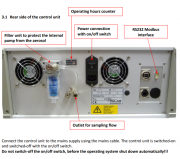
4.1 How to calibrate your sensor for the selected measurement range with CalDust1100?
To run the calibration procedure, connect a flexible tube to the aerosol inlet of the sensor. Hold
the free end of the flexible tube into the opening of the supplied CalDust 1100 container after
shaking the container to loosen the particles and make them air‐borne inside the container. By
doing so you provide that the air which is sucked into the sensor is primarily filled with particles of
a diameter of 0.85 µm. You must not shake too strongly as you must not have more than 10 %
coincident signals during the calibration procedure.
Calibration of the photomultiplier (PM) amplification:
The objective that has to be achieved hereby is to adjust the PM‐amplification (DAC) so that the
target channel of calibration matches the measured maximum of the raw data distribution. In‐
creasing/decreasing the PM‐amplification by increasing/decreasing the voltage will move the
measured maximum (channel of calibration) upward/downward.
The objective that has to be achieved hereby is to change the velocity (preset velocity) to the
measured velocity. You measure the velocity by moving the red cross into the right maximum
within the time chart. If the gas density of your measured aerosol doesn't change you do not have
to calibrate the velocity. However, during a calibration procedure one should always compare the
old particle velocity with the new particle velocity as a large deviation gives also an indication for a
leakage in your suction tubes or a problem with your suction pump. In case you have a pressure‐
resistant sensor, e.g. welas® sensor 2070 P, or a pressure‐resistant and heatable sensor, e.g. we‐
las® sensor 2070 HP, and if the pressure or temperature conditions change, you have to calibrate
and adjust the particle velocity as well. Always try to calibrate your sensor with CalDust 1100 at
the same pressure and temperature conditions as your subsequent measurements. However,
sometimes it is not possible to calibrate your sensor with a calibration dust at the same thermo‐
dynamic conditions. For this reason, you can also adjust the velocity without re‐adjusting the pho‐
tomultiplier amplification and without using a calibration dust. However, the particles have to be
larger than 0.4 µm. If you adjust the PM amplification, the velocity should not change. Alternative‐
ly you can activate the automated gas density correction.